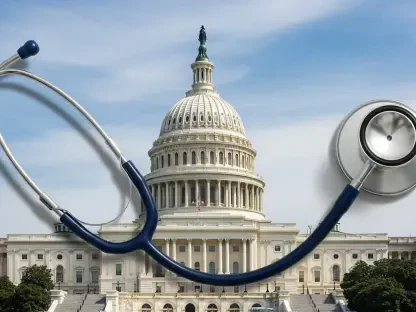Desiree Sainthrope, known for her deep understanding of legal frameworks and global compliance, brings a unique perspective to financial and regulatory complexities. In this interview, Desiree sheds light on the intricate history and ongoing discussions around the U.S. bank regulatory system, its challenges, and the influences of political decisions on its structure. Her insights delve into how historical events shaped today’s landscape and the perpetual debate over simplification and effectiveness in banking regulation.
Can you explain the historical context that led to the creation of multiple bank regulators in the U.S.?
The U.S. banking regulatory landscape is a result of historical events and responses to financial crises. Initially, the Office of the Comptroller of the Currency (OCC) was created in 1863 to address a chaotic system of state banks and currency. Over time, as crises revealed gaps in oversight, additional regulators like the Federal Reserve in 1913 and the Federal Deposit Insurance Corporation (FDIC) in 1933 were established. Each was created to address specific financial risks and crises, contributing to the multifaceted regulatory environment we have today.
Why do you think bank regulatory consolidation efforts have recurred every 15 to 20 years since the 1950s?
Consolidation discussions have persisted because the regulatory system is inherently complex, which often leads to inefficiencies and redundancies. Every so often, these challenges become prominent in public and political discourse, prompting calls for simplification. Yet, the balance of power, vested interests, and practical concerns over implementation tend to stall meaningful changes. As systems evolve and new financial products and services emerge, the call for restructuring is naturally part of maintaining applicable and effective oversight.
How does the current complex system of bank regulators benefit banks in terms of choice and competition?
The existing system provides banks with options regarding their regulatory framework. With multiple charter types available—federal, state member, and state non-member banks can choose a regulator that aligns more closely with their business objectives or operational strategies. This choice fosters competition among regulators to offer more favorable conditions or support to different types of banks, theoretically leading to more tailored oversight and innovation within the industry.
What challenges does the fragmented bank regulatory system pose for someone new to the industry?
For newcomers, the multitude of regulatory bodies and overlapping jurisdictions can be bewildering. Understanding which rules apply, how they interact, and the specific requirements each regulator imposes can be daunting. Navigating this landscape requires a significant investment in learning and compliance resources, which can be particularly challenging for smaller institutions with limited capacity.
How have federal banking agencies been created in response to financial crises?
Federal banking agencies have often emerged directly from the need to address gaps revealed by financial crises. The creation of the FDIC following the Great Depression exemplifies this, as it aimed to restore trust in banking systems by insuring deposits. Similarly, the Federal Reserve was established in response to the financial panic and instability in the early 20th century, specifically designed to provide liquidity and centralize monetary policy.
What role does congressional action play in the formal consolidation of bank regulators?
Congressional action is essential for any formal consolidation of bank regulators, as such changes require legislative approval. However, achieving consensus in Congress is challenging due to competing interests, political dynamics, and differing views about the roles and responsibilities of various regulators. Past attempts at consolidation demonstrate that while the idea may garner some support, aligning these interests to pass legislation is a formidable obstacle.
How do state and federal chartering create different incentives for banks?
State and federal chartering offer different regulatory environments and incentives, which banks can leverage based on their strategic needs. State charters might offer more flexible regulations and potentially lower costs, appealing to smaller or regionally-focused banks. Federal charters provide consistency in oversight and can be beneficial for banks operating across multiple states. The choice between them allows banks to select a framework that best aligns with their business model.
What are the key differences among federal agencies like the OCC, Fed, and FDIC?
Each agency has distinct roles. The OCC supervises national banks, the Federal Reserve manages monetary policy and oversees state member banks and holding companies, and the FDIC focuses on deposit insurance and resolving failed banks. These distinctions mean that each brings a particular perspective and set of priorities to their oversight, which historically has aimed to cover various aspects of banking and financial stability.
How does regulatory overlap across the system impact compliance costs for banks?
Regulatory overlap can significantly increase compliance costs for banks. Multiple agencies might impose similar yet differing requirements, leading to increased bureaucracy and the need for banks to spend more on compliance personnel and systems. The presence of numerous regulators in any single institution, as noted with the example of BofA, can lead to inefficiencies and a dilution of effort that might otherwise be more effectively directed toward core banking operations.
What was the significance of abolishing the Office of Thrift Supervision as part of the Dodd-Frank Act?
The abolition of the Office of Thrift Supervision under the Dodd-Frank Act marked a rare moment of consolidation aimed at reducing regulatory complexity. By transferring its responsibilities to the OCC and the Consumer Financial Protection Bureau (CFPB), the move aimed to streamline oversight and reduce the number of overlapping agencies, theoretically leading to clearer regulatory pathways and reducing costs associated with maintaining multiple supervisory bodies.
In what ways can merging functions among regulators impact innovation versus risk?
Merging regulatory functions could lead to a more cohesive regulatory strategy but also risks stifling innovation if it creates a less competitive environment. A single, powerful regulator might adopt more conservative policies to mitigate financial risks, potentially slowing down innovation. However, it can also result in clearer guidance and standards that help foster an environment where risks are managed more efficiently, potentially encouraging responsible innovation.
How does competition among various bank regulators benefit the banking system, according to former OCC head Michael Hsu?
Competition among regulators encourages agencies to improve their oversight and support frameworks, as they aim to attract banks to their charter. Such competition can drive better regulatory practices and lead to innovation in regulatory approaches, benefiting the banking system by offering institutions a greater choice in how they are supervised and ensuring that no single regulator becomes too authoritarian.
Why might small banks prefer the current system with multiple regulators?
Small banks may appreciate the current system because it provides them with more options and flexibility to meet their unique needs. By selecting a regulator whose policies and oversight align closely with their business model, small banks can better navigate regulatory requirements at a potentially lower cost. This system of choices can be especially advantageous when smaller banks seek to compete in a market dominated by larger institutions.
What are some of the inherent challenges in pursuing regulatory consolidation?
Consolidating regulators is fraught with challenges, including political resistance, loss of specialized expertise, and the complexity of merging organizations with distinct cultures and objectives. There’s also a risk of creating a too-centralized regulatory body that could lack the flexibility to address unique or local issues effectively. Moreover, consolidation could lead to increased bureaucracy and a one-size-fits-all approach that may not suit all banks.
How do the current staff cuts and restructuring efforts within banking agencies reflect the Trump administration’s intent to consolidate agencies?
The staff cuts and restructuring showcase an intent to downsize and potentially merge agency functions to reduce costs and streamline operations. The Trump administration’s emphasis on reducing federal size suggested a push towards more efficiency within regulatory frameworks through consolidation or better inter-agency coordination without necessarily requiring congressional approval.
In what ways could executive orders play a role in achieving regulatory consolidation?
Executive orders could facilitate non-legislative changes to agency operations and priorities, allowing for reorganization or consolidation of functions within the existing framework. While such orders might not directly merge agencies without legislative backing, they can set the stage for greater collaboration, share resources, or align regulatory objectives across different bodies.
How might greater coordination among federal banking agencies be achieved as per the Trump administration’s plans?
Greater coordination could be achieved by establishing clearer communication channels and shared objectives among agencies, possibly with the Treasury Department acting as a central coordinator. Aligning policy goals and streamlining processes can enhance efficiency and reduce unnecessary duplication of efforts, potentially creating a more unified regulatory environment without merging agencies.
What specific steps could be taken to increase efficiency within the current bank regulatory system?
Efficiency could be improved by standardizing certain regulatory requirements across agencies to minimize duplication, adopting technology to streamline compliance processes, and increasing information sharing among regulators to better leverage collective expertise. Regular reviews of regulatory overlaps and redundancies can also identify areas for improvement while maintaining effective oversight.
How can discussions around the bank regulator framework lead to enhanced supervision and efficiency?
Ongoing dialogue encourages critical evaluation and adaptation of the existing framework. By continuously assessing the effectiveness and efficiency of current practices, stakeholders can propose targeted adjustments that enhance supervision without sacrificing the benefits of diverse regulatory perspectives. Such discussions ensure the regulatory framework evolves with financial markets, addressing new risks proactively.
Why is it important to continually assess rather than assume the effectiveness of the current regulatory system?
Continuous assessment is crucial because financial markets and risks constantly evolve. Assuming current systems are effective can lead to oversight gaps, missed inefficiencies, and missed opportunities for improvement. Regular evaluations allow regulators to adapt to changes, ensuring that the systems in place protect consumers and maintain the stability of financial services in an ever-shifting landscape.









